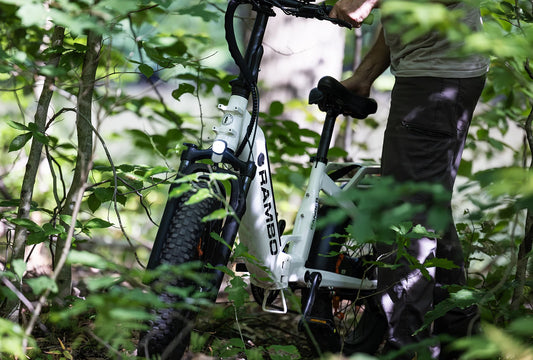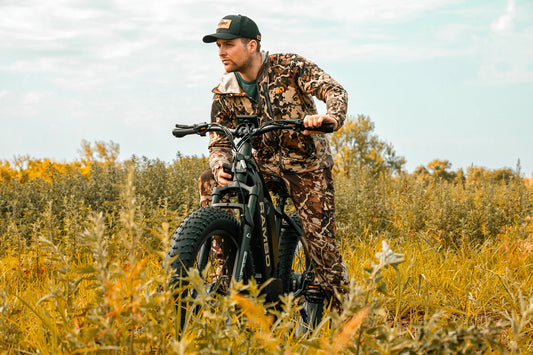The 4 Best E-Bikes for Backcountry Riding
While conservation groups continue to battle with overlanders and motorized sport vehicle riders across the country on restricting their access to certain public lands, there has seemingly been a truce made with the former group and e-bike riders.
Because of e-bikes' low impact on nature — something ATVs, UTVs, dirt bikes, and large overloading vehicles can’t boast — they are becoming popular means of travel on large swaths of backcountry such as Bureau of Land Management, National Parks, and state and Federal forests. And, while most of this can be found in the western portion of the country, there is some pressure on divisions of wildlife to allow — or, at least, consider allowing — the use of e-bikes for respectful users on the rugged terrains of the eastern United States that haven’t adopted policies yet.
In that vein, what are some of the most popular Rambo bikes for backcountry travel? While most Rambo bikes are suited for this rugged terrain, here’s the shortlist:
The Rambo Savage 2.0
The Savage 2.0 is a multifaceted e-bike for many pursuits. A favorite among hunters, the second iteration of the Savage boasts a strong 750-1,000-watt Bafang motor and a 48-volt LG battery, allowing riders to go up to 65 miles using pedal assist or 32 miles on throttle only.
The Savage 2.0 can reach speeds up to 30 miles per hour and is a comfortable ride, with a step-through frame, adjustable stem, and the option to upgrade to a Cloud 9 memory foam saddle seat and SR Suntour NCX suspension system.
Further, the model comes stock with 24-inch by 4-inch All-Terrain Kenda tires, bolstered with anti-puncture technology; however, buyers can upgrade their tires with Tannus Armor, further eliminating the chance of a flat on those long rides in the backcountry. Finally, the Savage 2.0 can be equipped with various accessories, from saddle bags to a gun, bow, and fishing rod holder.
The Rambo Nomad 2.0
Another comfortable model great for backcountry travel is the Nomad 2.0. With an upgraded front suspension and 90 Newton-meters of torque thanks to the powerful 1,000-watt Bafang motor, this is an excellent choice for anyone looking to spend serious time in the backcountry.
Like the Savage 2.0, the Nomad is quite customizable to ensure maximum comfort with the additions of the Suntour suspension and the Cloud 9 seats. Further, the Nomad 2.0 is incredibly quiet, ensuring the rider won’t disturb wildlife or other backcountry users.
The Nomad comes standard with 26-inch by 3-inch tires with the option to upgrade to Tannus Armor. This is highly recommended for this model as the stock tires don’t have extra puncture protection like the Savage 2.0. Additionally, the Nomad 2.0 comes with Rambo’s 48-volt LG battery to take you 65 miles using pedal assist or 32 miles of throttle only.
Finally, like the Savage 2.0, the Nomad 2.0 can reach speeds up to 30 miles per hour.
The Rambo Megatron 2.0
Third on the list is Rambo’s all-wheel drive Megatron 2.0, a true powerhouse for even the roughest backcountry trails.
With dual Bafang motors, the Megatron has a peak rating of 2,400 watts and boasts 190Nm of torque. And, in that vein, the dual 48-volt batteries can carry the Megatron and its user up to 80 miles — with a mix of peddle assist and throttle — while maxing out at 28 mph.
Like the Savage 2.0 and Nomad 2.0, owners can upgrade the Megatron to be as comfortable as it is powerful, with upgradeable seats and suspension for those long, secluded rides.
The Rambo Ranger Folding Bike
The final backcountry stud on the shortlist is the Ranger. Foldable and lightweight at just 62 pounds, the Ranger still boasts some incredible specifications.
Starting with its performance, the Ranger’s 750-watt Bafang motor gives the model 80Nm of torque, while the standard 48-volt battery will take riders up to 40 miles with a peak speed of 30 miles per hour. Further, the Ranger comes with 20-inch by 3 1/3-inch Kenda All-Terrain tires, excellent for the backcountry or forest trails.
The upgrade currently available for the Ranger is the seat — you can upgrade to either of the two Cloud-9 seats — and the pedals. There’s also room to attach Rambo’s Pro Hunter light and battery bank.
Final thoughts on using e-bikes for backcountry travel
While Rambo’s bikes are built for and tested in rugged conditions, it should be noted that riders should always consult with local, state, and Federal laws to be confident that they can take their bike out on the trail.
Some public lands restrict e-bike use entirely, while others allow riders to share trails already designated for manual bike use. Even further, some require the bike only be used below 20 mph, or on paved roads.
Currently, e-bikes are under a three-class system which can be broken down as:
- Class 1: An e-bike that has a motor that provides power for peddle-assist only and stops when the bike maxes out at 20 mph.
- Class 2: An e-bike that has a motor that provides power for peddling assist and a throttle that maxes out at 20 mph but doesn’t stop supplying power.
- Class 3: An e-bike that has a motor that provides power for peddle-assist and throttle that maxes out at 28 mph but doesn’t stop supplying power.
The Federal government and most states recognize this system, though some states have expanded upon it, such as motor and age restrictions. As of 2023, there are only 14 states that don’t use the three-class system. They are Alaska; Delaware; Hawaii; Kansas; Kentucky; Massachusetts; Montana; Nebraska; New Mexico; North Carolina; Oregon; Pennsylvania; Rhode Island; and South Carolina. Washington D.C. also doesn’t recognize the Federal classification.
Rules and distinctions vary between these states, so be certain to check their guidelines. Overall, with e-bikes being a relatively new and incredibly popular addition to the biking world, it’s best to check rules about the public land you wish to ride on. Even the various Federal lands have different rules, so know what you can do before you go out on an adventure.






